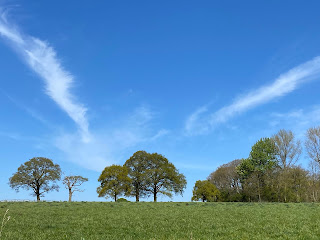We were spending a few days in Granada after a week walking in the Alpujarras. One of the highlights of visiting the city is the Alhambra, a thirteenth century fortress built by the Moors. We purchased tickets online and set off on foot from the hotel.
 |
| The lovely city of Granada |
Part of the route took us up a very steep flight of steps on the Cuesta Del Realejo. My wife and friends were ahead, as I had stopped to take photographs. Suddenly I felt something strike my hat and trickle down my back. I looked around and there was a Spanish looking man and woman nearby. The man pointed up at t
he sky and said; "Bird!" He looked me over and tut tutted, then added. "Come with me - I will get you cleaned up!"
I followed him into a nearby bar. There was only one thing on my mind - I was covered in bird crap and I had to get rid of it! The bar was fairly busy, and he led me to the back where there was a toilet cubicle and wash basin. He produced a pack of tissues and told me to remove the small backpack I was carrying. It was splattered with a thick darkish liquid, as was my hat and shorts. As I washed the hat in the sink, he wiped off the worst of it from my shorts. I was very grateful to him, and muttered "Mucho gracias," as he left me to finish.
 |
| We decided to visit the Alhambra... |
Outside there was no sign of the helpful Spaniard nor the woman. My wife and friends were at the top of the steps waiting. They were aware something had gone on, but weren't sure where I was. I explained what had happened and we continued to the Alhambra.
We looked around the gardens, then decided to eat lunch before tackling
the palace buildings. The tapas was excellent, and when we received the bill, I took out my wallet to pay. I opened it and it was empty. I stared in disbelief. My credit cards and driving licence was there, but almost four hundred euros in notes were missing! The penny dropped. I hadn't been hit with bird muck, but some concoction that had been thrown over me, the Spaniard wasn't a Good Samaritan, but a thief, and I had fallen victim to a bizarre scam! I'd said earlier that there was so much crap on me that the bird must have had diarrhea! The wallet had been in my shorts...
 |
| The Cuesta Del Realejo - where the scam took place... |
On the way back we called in at the bar and spoke to the owners. By their reaction I'm sure they were not involved in the crime - but it was worth warning them in case the thief tried using their premises again.
I called in the police station near our hotel, and was told to visit an office in the Tourist Information building the following morning to report the crime. We didn't hold out much hope. I imagined we'd see a civilian, and it would be a tick-box exercise, and we'd leave with a crime number to give our insurance company. It was nothing like that.
We were greeted by a very polite police officer who took details, then asked for a statement. This was all recorded on his computer. He apologised several times for the experience I had gone through, and told me my story was not unique, although it was two months since they had received a similar report. Finally, he enquired if I would return to the police station and look at some mug shots. I agreed and he made a phone call to set up the interview.
 |
| The scene of the crime... |
At the police station we were sent upstairs to an office where I was greeted by two detectives; a
male and female. I was shown images of convicted criminals and none matched the description. And then there he was, staring from the screen, black hair and beard, small mouth and shifty eyes. Now I had a name for him: 'Bartoli'.
They had CCTV footage of him. He was wearing a hat to hide his face, but it was his build, his height, his gait - just as I had described him. I was only a year out in his age too! They printed out Bartoli's mug shots and asked me to sign my name across them.
The detectives thanked me and said they would try and trace the scammer and make an arrest. The Spanish Embassy would make contact if they needed anything else.
So, how did I feel? Foolish, certainly, but I have to admit a small part of me was intrigued by the weirdness of it. To think up such a scam! "I have a great idea," you can imagine Bartoli telling a criminal associate, " I'm going to create some fake bird shit, throw it over a tourist, offer to clean them up, and in the process steal their money..." And the psychology involved. The revulsion of being covered in bird crap overrode all sense of caution and suspicion. I
had to get cleaned, and this kind passerby was going to assist me...
The fact he appeared to be with a woman added to my acquiescence. If he'd been alone or with another man I may have thought twice. Ironically, I'm not sure now that he
was with a woman. Certainly there was a woman near him, but she could have been someone just walking up the Cuesta Del Realejo, and I falsely connected the two. According to the police officer, Bartoli worked alone...
They say that getting covered with bird poo is lucky. Unfortunately it wasn't the real stuff!





























